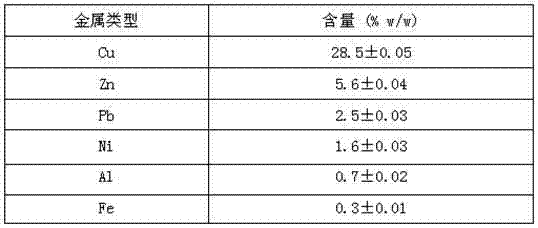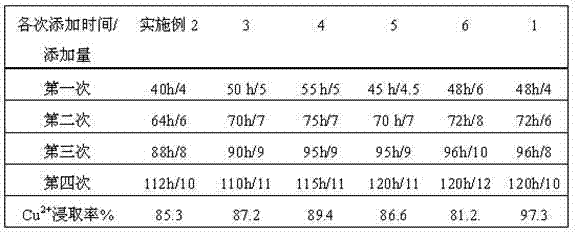Method for extracting copper out of waste printed circuit board by employing mixed bacteria
A technology of printed circuit boards and mixed bacteria, applied in the direction of microorganism-based methods, methods using microorganisms, biochemical equipment and methods, etc., can solve the problems of copper leaching ability decline, achieve copper leaching rate improvement, improve resistance Copper property, energy saving effect
- Summary
- Abstract
- Description
- Claims
- Application Information
AI Technical Summary
Problems solved by technology
Method used
Image
Examples
Embodiment 1)
[0029] The method for leaching copper in waste printed circuit boards by mixed bacteria of the present embodiment includes the following steps:
[0030] ①Pretreatment of waste printed circuit boards. Crush and grind the waste printed circuit board PCBs with electronic components removed into powder, and the ground waste PCBs powder passes through 100 μm to 200 μm sieve holes (in this example, the ground waste printed circuit board powder passes through 100 μm sieve holes) , to collect the waste PCBs powder passing through the sieve hole for disposal.
[0031] After the waste PCBs treated in this example were ground and sieved, the main metal content was analyzed.
[0032] The main metal contents are shown in Table 1 below:
[0033] Table 1 Main metal content in waste printed circuit board powder
[0034]
[0035] ② domestication of strains.
[0036] (1) Thiobacillus acidophilus ferrooxidans ( A. ferrooxidans ) domestication. It is obtained by enriching and culturing...
Embodiment 2 to Embodiment 6)
[0065] The method for leaching copper in the waste printed circuit board from the mixed bacteria of Example 2 to Example 6 is the same as in Example 1, and the difference is: step 3. the content of each component in the mixed bacteria culture solution used in the mixed bacteria culture As well as the addition time and addition amount of the waste printed circuit board powder in step (4), see Table 2 and Table 3 below for details.
[0066] Table 2 The content of each component in the mixed bacterial culture solution used in step ③ mixed bacterial culture
[0067]
[0068] Table 3 Step ④ Addition time and amount of waste printed circuit board powder
[0069]
[0070] Note: The addition time described in the above table refers to the time when the powder is added after the start of the culture of the mixed bacteria in step ③; the added amount refers to the weight of the waste printed circuit board powder added per 1L of the mixed bacteria culture system , in grams.
PUM
 Login to View More
Login to View More Abstract
Description
Claims
Application Information
 Login to View More
Login to View More - R&D
- Intellectual Property
- Life Sciences
- Materials
- Tech Scout
- Unparalleled Data Quality
- Higher Quality Content
- 60% Fewer Hallucinations
Browse by: Latest US Patents, China's latest patents, Technical Efficacy Thesaurus, Application Domain, Technology Topic, Popular Technical Reports.
© 2025 PatSnap. All rights reserved.Legal|Privacy policy|Modern Slavery Act Transparency Statement|Sitemap|About US| Contact US: help@patsnap.com



